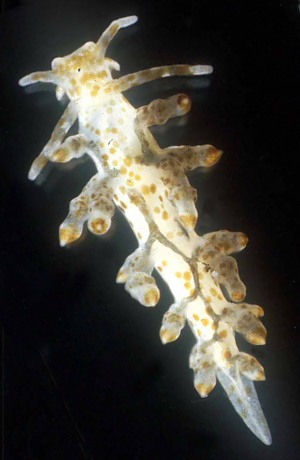
Eubranchus misakiensis
Baba, 1960
Order: NUDIBRANCHIA
Suborder: AEOLIDINA
Family: Eubranchidae
DISTRIBUTION
Japan, Hong Kong. If all the reports in the Forum are this species also then it also has a wide distribution in North America from British Columbia to California.
PHOTO
Mukaishima, Seto Inland Sea of Japan. Photo: Yoshiako Hirano.
Yoshi and Yayoi Hirano have published to interesting studies showing that this species in Japan feeds exclusively on hydroids of the genus Obelia, while another species, E. horii, which is found abundantly with E. misakiensis feeds only on Plumularia filicaulis.
NOTE: Reports below suggest this species has a wide distribution on both the west and east coasts of the northern Pacific BUT note Bernard Picton's message suggesting there are a number of species involved here.
References:
• Baba, K. (1960). Two new species of the genus Eubranchus from Japan (Nudibranchia - Eolidacea). Publications of the Seto Marine Laboratory, 8(2): 299-302, Pl 34.
• Behrens, D. W. (1971). Eubranchus misakiensis Baba 1960 (Nudibranchia: Eolidacea) in San Francisco Bay. The Veliger, 14(2): 214-215.
• Hirano, Y.J. & Hirano, Y.M. (1985) Feeding segregation of two sympatric eubranchiid nudibranchs (Aeolidacea). Experimental Biology, 44: 215-220.
• Hirano, Y.J. & Hirano, Y.M. (1990) Feeding segregation of Eubranchus misakiensis Baba, 1960 and E. horii Baba, 1960 in the Okhotsk Sea, Northern Japan with range extensions for both species. Venus, The Japanese Journal of Malacology, 49: 146-149.
Rudman, W.B., 2001 (March 6) Eubranchus misakiensis Baba, 1960. [In] Sea Slug Forum. Australian Museum, Sydney. Available from http://www.seaslugforum.net/find/eubrmisa
Related messages
Re: which is Eubranchus misakiensis?
July 15, 2003
From: Jeff Goddard
Dear Bill,
Marli Wakeling's photos identified as Eubranchus misakiensis? and posted on June 25, match exactly what I have until recently called the outer coast form of Eubranchus olivaceus (O'Donoghue, 1922) (as opposed to the more greenish colored form found on Obelia in the inland water ways of Washington, British Columbia and Alaska). The outer coast form is usually found on the hydroid Plumularia, which is visible in one of Marli's photos.
Sandra Millen, who has been examining the northeastern Pacific species of Eubranchus recently confirmed that my specimens of E. olivaceus from the outer coast of Oregon and Washington are the same as the specimens found in the inland waterways. Sandra also agrees with Alexander Martynov (Martynov, 1998) that E. olivaceus is a synonym of E. rupium (Moller, 1842) from the north Atlantic, and a look at the photo of E. rupium on Bernard Picton's British nudibranchs website shows that externally there is indeed no difference. Lemche, as described in Just & Edmunds (1985:114), also considered E. olivaceus the same as E. rupium.
Eubranchus rupium is therefore circumboreal in distribution.
References:
• Goddard, J.H.R. & N.R. Foster (2002) Range extensions of sacoglossan and nudibranch mollusks (Gastropoda: Opisthobranchia) to Alaska. The Veliger, 45(4): 331-336.
• Just, H. & M. Edmunds (1985) North Atlantic Nudibranchs (Mollusca) Seen by Henning Lemche. Ophelia Publications: Marine Biological Laboratory, Helsingor, Denmark. 170 pp.
• Martynov, A.V. (1998) Opisthobranch mollusks (Gastropoda: Opisthobranchia) of the family Eubranchidae: Taxonomy and two new species from the Sea Of Japan. Zoologicheskii Zhurnal, 77: 763-777.
Best wishes,
Jeff
goddard@lifesci.ucsb.edu
Goddard, J., 2003 (Jul 15) Re: which is Eubranchus misakiensis?. [Message in] Sea Slug Forum. Australian Museum, Sydney. Available from http://www.seaslugforum.net/find/10325Dear Jeff,
Thanks for this interesting complication to the story. I thought we had at last sorted out what was E. misakiensis on the west coast of North America. Following Bernard Picton and others work on food specificity in species of Eubranchus, I hesitate to accept that different looking animals on different food hydroids [your outer coast and inland water forms] are the same species. For example Yoshi and Yayoi Hirano have shown that E. misakiensis in Japan feeds exclusively on hydroids of the genus Obelia, while another species, E. horii, which is found abundantly with E. misakiensis feeds only on Plumularia filicaulis. So I think I'll leave Marli's animal as possible E. misakiensis at present, although it is apparently on a species of Plumularia. The only photo I have seen of the greenish form of E. olivaceus is in Behrens (1991). It certainly could be the same as E. rupium. I would think the animal from the east coast of Nth America, Eubranchus cf. olivaceus, is certainly Eubranchus rupium.
Best wishes,
Bill Rudman
Re: Which is Eubranchus misakiensis?
June 25, 2003
From: Marli Wakeling
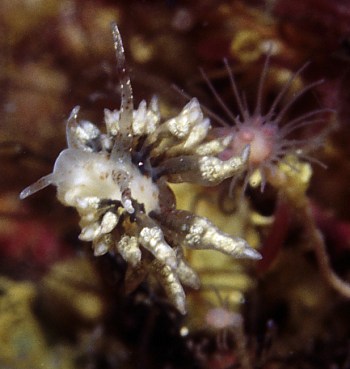
Hi Bill,
I have some new photos to share of some Eubranchus misakiensis - type critters from the Broughton Archipelago in British Columbia. The upper right and lower left photos are very distinctive, as they appeared black and white to the eye, while the lower right photo seems closer to my previous postings, paler, with a lighter digestive tract. All have banded rhinophores, reddish brown spots of varying degrees. The darker specimens have a white dusting on the rhinophores, also. As I did collect several specimens, perhaps we can get an answer to what these tiny beauties are.
Location: Broughton Archipelago, British Columbia
Dive Site: Marg's Wall
Size: 4mm
Depth: 35 feet
Date: August 9, 2002
Photos: Marli Wakeling
Regards,
Marli Wakeling
scubamarli@excite.com
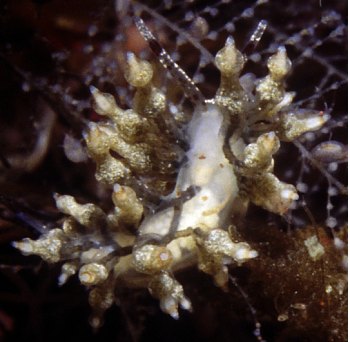
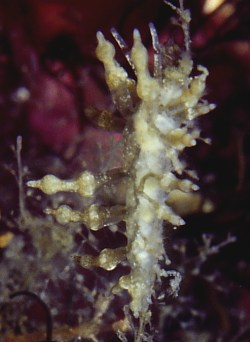
Thanks Marli,
These are an interesting addition to the story.
Bill Rudman
Re: Which is Eubranchus misakiensis?
September 13, 2002
From: Nishina Masayoshi
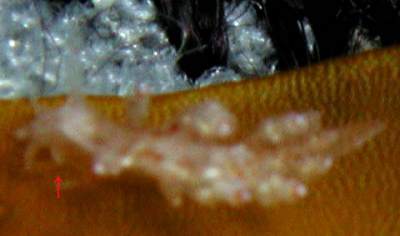
Dear Bill,
I am very glad to read the best advice from Dr. Hirano. I think the animal which I posted on July 18, 2001 is not of E. misakiensis. Another of my animals which I posted on May 25, 2002 is probably E. misakiensis, as is Dave Behrens's animal of May 25, 2002.
I tried to find good photo of the short horn shaped foot corners which Dr.Hirano mentioned. But I could not. Although the attached photo is not very good I think it shows the foot corners as described by Dr Hirano. This is a photo of same individual I posted on May 25, 2002
Best Regards,
Nishina Masayoshi
nishina@wips.co.jp
Masayoshi, N., 2002 (Sep 13) Re: Which is Eubranchus misakiensis?. [Message in] Sea Slug Forum. Australian Museum, Sydney. Available from http://www.seaslugforum.net/find/7945Thanks Nishina,
At least I now feel happy about the identity of Eubranchus misakiensis.
Best wishes,
Bill Rudman
Re: Which is Eubranchus misakiensis?
September 13, 2002
From: Dave Behrens
Dear Bill & Yoshi:
Yoshi's photo looks exactly like Baba's original drawing and others he sent to me while I was evaluating the San Francisco Bay specimens.
After staring at Marli's photos again, I am not sure what to tell you. I do agree they are not E. misakiensis. My error. But I am not sure I'd call them E. rustyus either, unless these are very pale specimens. It is possible. Let's go with Eubranchus cf. rustyus for now.
Dave Behrens
dave@seachallengers.com
Behrens, D., 2002 (Sep 13) Re: Which is Eubranchus misakiensis?. [Message in] Sea Slug Forum. Australian Museum, Sydney. Available from http://www.seaslugforum.net/find/7955Thanks Dave,
Bill Rudman
Which is Eubranchus misakiensis?
September 11, 2002
From: Yoshiaki J. Hirano

Dear Bill,
Here is a photograph of Eubranchus misakiensis, which I took nearly 15 years ago. I collected the specimen in Mukaishima, Seto Inland Sea of Japan. I have been asked by you to confirm the identity of Bernard Picton's animal on March 10, 2001. I am very sorry that it took me really long to respond to it and later messages on the species.
In the case of E. misakiensis, too, intraspecific variation should obscure species identification, but from my experiences working on the species in Mukaishima and Abashiri (Okhotsk Sea) I do not have any impression that it is a very variable species in colouration: The original description by Dr Baba shows general ground-colour yellowish white; it is scattered with chocolate-brown spots everywhere on body, on cephalic tentacles and rhinophores, and on gills. Sole coloureless. Each of the branchial paillae with a yellow subapical ring and a bluish green liver-vein. These characters seemed always stable also when I observed several specimens found here in Kominato, Boso Peninsula. So, specimens with colouration very different from that of E. misakiensis seem rather different species than just variation. Plus, I think shape of foot corner is an important character to identify species. Please note the short horn shaped foot corners in my photo. But unfortunately with most of the photographs posted on the Forum I cannot clearly see that character. The followings are my comments on the photographs on the Forum.
I would like to give them following the chronological order of the posted photographs.
•(1) Those on Mar 10, 2001 by Bernard seem not of E. misakiensis, chiefly because it has too dense spots and quite different colour pattern on the cerata. (I hope this problem has been already solved.)
(2) As Erwin Koehler suggested on May 16, 2001, the picture in Dave Behren's book seems of E. misakiensis. I agree with Erwin on this.
(3)Those by Nishina Masayoshi on July 18, 2001 are probably not of E. misakiensis, because spots on the body are scarce and very red. Unfortunately the shape of foot corners cannot be seen from the photo. This animal looks very similar to that of the photograph of No. 222 on Opisthobranchs of Izu Peninsula by Keiu Suzuki (2000) and that of No. 1 of p. 802 of Marine Mollusks in Japan edited by Takashi Okutani (2001). The photograph No. 218 of Keiu's book is of E. misakiensis, I believe, but the animal on No. 222 looks very different from many specimens of E. misakiensis I have seen.
(4) The picture by Dave Behrens on May 25 is probably of E. misakiensis, as I mentioned above.
(5) Those by Marli Wakeling in two separate messages on May 25 (on which Dave Behrens agreed on species identification), and those by Nishina Masayoshi on the same day altogether seem not of E. misakiensis. As Marli mentioned in the first message, the animal reminds me of Eubranchus rustyus from the west coast of the US, but may be something else. The hydroid on which Marli's animals are crawling looks like a species of Plumularia or some related genus. I feel there are not any positive reasons to assign the specimen to E. misakiensis.
Best wishes,
Yoshi
hiranoyj@earth2.s.chiba-u.ac.jp
Hirano, Y. J., 2002 (Sep 11) Which is Eubranchus misakiensis?. [Message in] Sea Slug Forum. Australian Museum, Sydney. Available from http://www.seaslugforum.net/find/7895Dear Yoshi,
Your photo is very welcome. Many of the species which have been described from Japan, including Eubranchus misakiensis, were not well illustrated in their original descriptions, and so cause problems for us who are unfamiliar with your fauna. In the black and white drawing accompanying the descriptions of this species, the spots are drawn much smaller than in your photo. That is why I have been waiting for someone from Japan with a personal knowledge of these species to help us determine which of the brown-spotted species is E. misakiensis. Now that I have seen your photo I agree with your comments that the only other animal on this page that looks like . misakiensis is Dave Behrens' from California.
It would be good to have a comment from Dave on Marli's animals from Canada. Are they likely to be E. rustyus? I see that the Marcus's description of E. rustyus is another example of an unfortunately uninformative description. The specimens were described from decolorised preserved animals, the only information on the live animal being 'The living animals were white to translucent with pink cerata'.
I think I will remove all the 'non-misakiensis' photos from this page but before I do so I will see if anyone can give me any clues to their real identity. For example, the animal in Nishina's message from Japan has a distinctive colour pattern and ceratal shape. I have checked all the species I think have been described from Japan without success, but perhaps I have missed one.
best wishes,
Bill Rudman
Eubranchus misakiensis in California
May 25, 2002
From: Dave Behrens
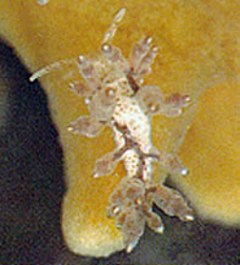
Bill:
Here is a photo of the aeolid from San Francisco Bay that we have identified as Eubranchus misakiensis Baba, 1960 and considered to be another Japanese introduction (Behrens 1971) that has become permanently established. As in Japan, this species feeds exclusively on Obelia. The substrate in the attached photo is artificial. This specimen was one of hundreds observed over the years in central San Francico Bay since first mentioned to me back in 1970 by Joan Steinberg.
Reference:
• Behrens, D. W. 1971. Eubranchus misakiensis Baba 1960 (Nudibranchia: Eolidacea) in San Francisco Bay. The Veliger, 14(2): 214-215.
Dave Behrens
dave@seachallengers.com
Behrens, D., 2002 (May 25) Eubranchus misakiensis in California. [Message in] Sea Slug Forum. Australian Museum, Sydney. Available from http://www.seaslugforum.net/find/4863Thanks Dave,
You sent this some time ago and I had been trying to get some photos of 'definitive' Japanese specimens to post simultaneously. But as the other meesages I am posting today suggest, defining a 'typical' E. misakiensis seems to be the problem.
Best wishes,
Bill Rudman.
Eubranchus misakiensis? from British Columbia
May 25, 2002
From: Marli Wakeling
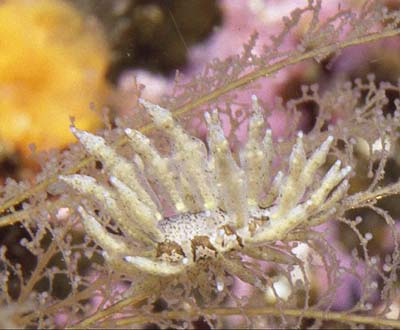
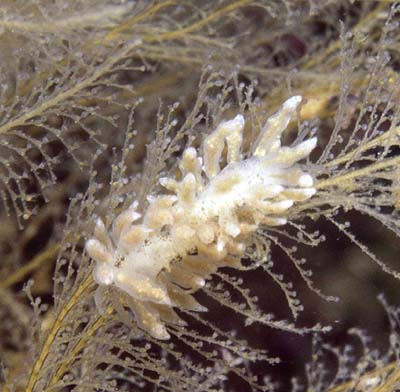
Hi Bill,
Here are some photos from August 2001 from the Port Hardy area of British Columbia. Dave Behrens thinks they may be Eubranchus misakiensis, found in Japan and until now, San Francisco Bay, thought to be brought in the ballast of a freighter. I also found more in Campbell River in October, again on feather hydroids, with small comma shaped egg masses. The other possibility is Eubranchus rustya, but they don't resemble the photo reference I have for that animal.
Location: Port Hardy, British Columbia, Canada.
Date: August, 2001
Depth: 40 feet
Length: 4 to 6 mm
Photographs: Marli Wakeling
Marli
scubamarli@excite.com
Wakeling,M., 2002 (May 25) Eubranchus misakiensis? from British Columbia. [Message in] Sea Slug Forum. Australian Museum, Sydney. Available from http://www.seaslugforum.net/find/5597Thanks Marli,
I'm afraid this message has been languishing in the Forum backlog, but since the arrival today of a second report from you of this animal in Canada, I have declared today Eubranchus misakiensis Day and am posting all the messages I have on the species. What will need further research is whether all these 'forms' are a single species or a group of species. If they are a group of species which one id E. misakiensis? I am afraid the original description does not suggest there is much colour variation, but in the photos we know have on the Forum, the brown spots vary from a few small scattered pale spots to a dense pattern of pale spots, or a sparse scattering of larger dark spots. Apart from colour, Baba mentions the shape of the cerata with a 'boss' in the middle of the digestive gland duct. He also mentions the angulate, almost tentacular, anterior corners to the foot. Unfortunately I can't see the shape of the anterior foot in any of the photos on the Forum. I also don't know whether the brown patches, which are clearly visible on the body of the animal in these photos, are significant or not. Thanks for the photos, and sorry they have been a while in the queue.
Best wishes,
Bill Rudman.
Is this Eubranchus misakiensis?
May 25, 2002
From: Nishina Masayoshi

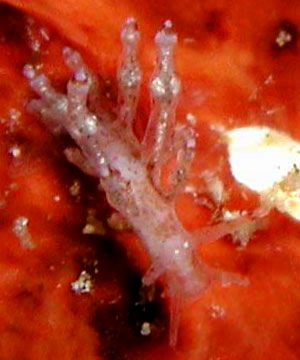
Dear Bill,
My wife found this animal at Echizen coast. I feel this animal is a kind of Eubranchidae. I feel that this may be Eubranchus misakiensis. I also feel my animal and the animal identified as E.misakiensis by Dave Behrens are the same.
However, this animal does not look like the animal that I posted before and you identified as E.misakiensis. Or there is another possibility that this may be E. horii Baba, 1960?
Date:4 May, 2002
Location: Echizen coast, Fukui Pref. Japan
Length: 5mm
Depth: 5m
Found and photographed by N. Chikako
The animal was found on algae (upper photo) and moved to another place for the lower photo.
Best Regards,
Nishina Masayoshi
nishina@wips.co.jp
Masayoshi, N., 2002 (May 25) Is this Eubranchus misakiensis?. [Message in] Sea Slug Forum. Australian Museum, Sydney. Available from http://www.seaslugforum.net/find/6974Dear Nishina & Chikako,
As you will see from the other messages I have posted today, the identity of E. misakiensis is not altogether clear. Some species are quite variable in colour and when they are described and named from only a few specimens, we often have no idea just how variable they are in colour. That is why I welcome photos even of species we already have photos of, because it gives us an opportunity to see just how variable some species can be. Of course no conclusions can be reached until anatomical studies are carried out but at least it helps us to know which species, or groups of species, are problematical, and which are not.
I am pretty sure your animal is not E. horii, because that species was described as having regularly shaped cerata, without swellings, rounded anterior foot corners, and no spots. The colour pattern consists of brown bands that runs across the head from the oral tentacles to the inside base of the rhinophores. There is also a brown streak in the dorsal midline between the first and second groups of cerata.
I am sorry that some of these animals are proving difficult to identify, but all the photos you and our other friends in Japan are sending to the Forum are very valuable in helping us to better understand the fauna, and hopefully will help us to resolve these identification problems.
Best wishes,
Bill Rudman
Eubranchus misakiensis from British Columbia
May 25, 2002
From: Marli Wakeling
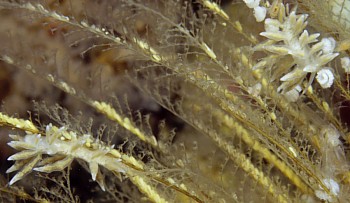
Dear Bill,
I was diving in the Broughton Archipelago on the east coast of Vancouver Island, and once again found a lot of these nudibranchs. Dave Behrens has I.D.'d it as Eubranchus misakiensis, originally from Japan.
Dive Site: Stephanson's Reef, Broughton Archipelago, British Columbia, Canada.
Depth: 45 feet
Length: 5mm
Date: May 18, 2002
Photograph: Marli Wakeling
Marli.
scubamarli@excite.com
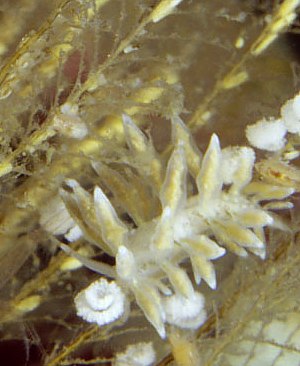
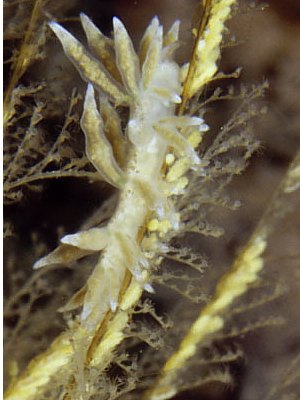
Thanks Marli,
As you will see from the other E. misakiensis messages I am posting today, I have decided to bite the bullet and post a number of 'queued' messages about this 'species'. I am not sure if they are all E. misakiensis but hopefully it will encourage further discussion on the topic. It is interesting that the animals in this photo do not have the brown patching which was such a feature of your earlier photos. Perhaps you could check whether this is a variable character, present in some animals and not others? It would also seem from these photo that the brown spots are also optional - or is it just that I can't see them in the specimen in the lower left photo?
The other feature which would be good to know about is whether the front corners of the foot are rounded, or whether they are extended out into short tentacles. In Baba's original description he mentioned tentacular (or angled) anterior foot corners.
Thanks again for the photos,
Best wishes,
Bill Rudman
Eubranchus misakiensis from Vancouver, Canada
May 25, 2002
From: David Behrens

Dear Bill,
Marli Wakeling's photos of this aeolid from British Columbia are very interesting. I am quite sure it is Eubranchus misakiensis Baba 1960 from Japan. I published a note years ago after learning that this species had been introduced into San Francisco Bay, where it has become quite well established. I had heard from Gordy Robilliard and others that it also occurred up in Washington and Canada but had never received any kind of proof. Marli's specimens are from the north east end of Vancouver Island, British Columbia at Broughton Archipelago. Apparently there were numerous specimens and has been observed yearly for some time now. I now wonder if this indeed was an introduction to the west coast of North America from Japan, or if Baba found it and described it from Japan before someone did here? Would we have said it was introduced to Japan if Gordy or I had described it when we found it in the 1970's? Or could this just be a circum-North Pacific species? Food for thought.
• Behrens, D. W. 1971. Eubranchus misakiensis Baba 1960 (Nudibranchia: Eolidacea) in San Francisco Bay. The Veliger, 14(2): 214-215.
Dave
dave@seachallengers.com
Behrens, D., 2002 (May 25) Eubranchus misakiensis from Vancouver, Canada. [Message in] Sea Slug Forum. Australian Museum, Sydney. Available from http://www.seaslugforum.net/find/7064Thanks Dave,
Your comments and Marli's most recent photo have encouraged me to pull out some messages on the same topic which have been languishing in my backlog. As you will see from my earlier comments, I have had some difficulty understandimg how variable this species is. It certainly would be interesting to look at colour variation in different populations of this 'species' and to compare their anatomy.
Best wishes,
Bill Rudman
Eubranchus from Hachijo Is, Japan
July 18, 2001
From: Nishina Masayoshi

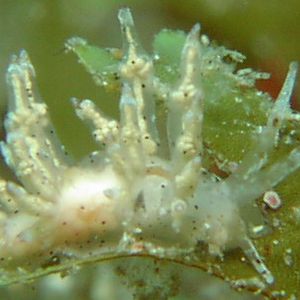
Dear Dr.Rudman,
Here is another of the small animals that my friend Mr.Jun Imamoto found and photographed on our recent visit [July 2001] to Hachijo Island, Izu-Islands, about 300 k south of Tokyo, Japan
They were found at 6-7M depth and were all around 5mm, long.
Best Regards,
Nishina Masayoshi
nishina@hpe15.wips.co.jp
Nishina, M., 2001 (Jul 18) Eubranchus from Hachijo Is, Japan. [Message in] Sea Slug Forum. Australian Museum, Sydney. Available from http://www.seaslugforum.net/find/4738Dear Nishina,
I think this is Eubranchus misakiensis. In Baba's original description he mentions the characteristic swelling of the digestive gland duct.
If this is so, then Bernard Picton's animal from Hong Kong, which we have identified as E. misakiensis, is probably something else. I suspect it is Eubranchus rubropunctatus Edmunds, 1969. The only difference would seem to be the absence of the red spots from the subapical blue band
Best wishes,
Bill Rudman
Re: Eubranchus misakiensis from Hong Kong
March 16, 2001
From: Erwin Koehler
Dear Bill
at http://www.biology.ucsc.edu/classes/bio161l/NUDI/emisakie.html is a photo of it from California, this increases its distribution a little bit ...
Erwin
Erwin@medslugs.de
Koehler, E., 2001 (Mar 16) Re: Eubranchus misakiensis from Hong Kong. [Message in] Sea Slug Forum. Australian Museum, Sydney. Available from http://www.seaslugforum.net/find/3962Thanks Erwin,
Yes this is the photo that is in Dave Behren's book. He reported it from the San Francisco region, California in 1971. There is a difference between the natural distribution, or geographic range of a species, and records which appear to be the result of human activity. I suspect its presence in San Francisco is the result of human activity. So as not to confuse 'natural' and 'unnatural' distributions, I think it is probably best to use 'distribution' only when we are talking about a natural distribution. However there is no way to standardise such usage of words so we just have to be aware that these days, species can turn up in strange places.
Reference: Behrens, D.W. (1971) Eubranchus misakiensis Baba, 1960 (Nudibranchia: Eolidacea)) in San Francisco Bay. The Veliger, 20(1): 214-215.
Best wishes,
Bill Rudman
